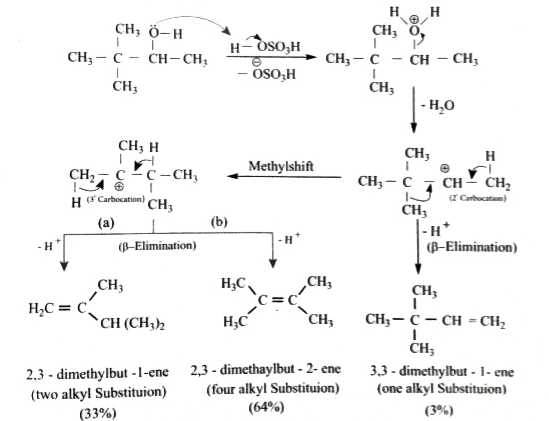Describe Saytzeff's rule with example.
(i) During intramolecular dehydration, if there is a possibility to form a carbon - carbon double bond at different locations, the preferred location is the one that gives the more (highly) substituted alkene i.e. the stable alkene.
(ii) For example, the dehydration of 3,3 dimethyl - 2- butanol gives a mixture of alkenes. The secondary carbocation formed in this reaction undergoes rearrangement to form a more stable tertiary carbocation.

Topper's Solved these Questions
- BOOK - FULL MARKSCHAPTER - HYDROXY COMPOUNDS AND ETHERSEXERCISE - ADDITIONAL QUESTIONS (Assertion and reasons)20videos
HYDROXY COMPOUNDS AND ETHERS
- BOOK - FULL MARKSCHAPTER - ELECTRO CHEMISTRYEXERCISE - ADDITIONAL QUESTIONS -5- MARK QUESTIONS15videos
ELECTRO CHEMISTRY
- BOOK - FULL MARKSCHAPTER - IONIC EQUILIBRIUMEXERCISE - ADDITIONAL QUESTIONS (5 MARK QUESTION)15videos
IONIC EQUILIBRIUM
Similar Questions
Knowledge Check
- Question 1 - Select One
Dehydrohalogenation involves removal of the halogenn atom together with a hydrogen atom from carbon adjacent to the one with halogen atom. Alcoholic KOH is used for dehydrohalogenation. According to saytzeff's rule, when two alkenes may be formed, the alkene which is most substituted is the major product.
Q. The ease of dehydrohalogenation for different halogens is in the orderAiodidegtbromidegtchlorideBbromidegtiodidegtchlorideCchloridegtbromidegtiodideDiodidegtchloridegtbromide - Question 2 - Select One
Dehydrohalogenation involves removal of the halogenn atom together with a hydrogen atom from carbon adjacent to the one with halogen atom. Alcoholic KOH is used for dehydrohalogenation. According to saytzeff's rule, when two alkenes may be formed, the alkene which is most substituted is the major product.
Q. The ease of dehydrohalogenation for different halogens is in the orderAiodidegtbromidegtchlorideBbromidegtiodidegtchlorideCchloridegtbromidegtiodideDiodidegtchloridegtbromide - Question 3 - Select One
Dehydrohalogenation involves removal of the halogenn atom together with a hydrogen atom from carbon adjacent to the one with halogen atom. Alcoholic KOH is used for dehydrohalogenation. According to saytzeff's rule, when two alkenes may be formed, the alkene which is most substituted is the major product.
Q. What are the products of dehydrohalogenation of 2-iodopentane?A2-Pentene(major),1-Pentene (minor)B1-Pentene (major), 2-Pentene (minor)C2-Pentene (50%), 1-Pentene (50%)DNone of these
Exception Of Saytzeff Rule
View SolutionWrite a chemical reaction to illustrate Saytzeff's rule.
View SolutionWrite short notes on the following
(a). Saytzeff's rule
(b). Balz-Schiemann reaction.View SolutionDehydrohalogenation involves removal of the halogenn atom together with a hydrogen atom from carbon adjacent to the one with halogen atom. Alcoholic KOH is used for dehydrohalogenation. According to saytzeff's rule, when two alkenes may be formed, the alkene which is most substituted is the major product.
Q. What are the products of dehydrohalogenation of 2-iodopentane?View Solution(A)CH3CI∣CHCH2CH3alc.KOH−−−−−→CH3CH=CHCH3<br>+KCI +H_(2)O
Dehydrohalogenation reaction of 2-chlorobutane gives 2-butene.
(R) Elimination reaction takes place according to Saytzeff's rule.View Solution
